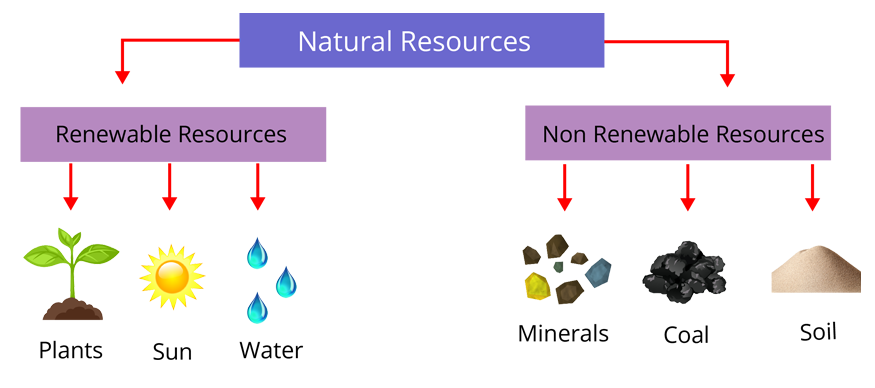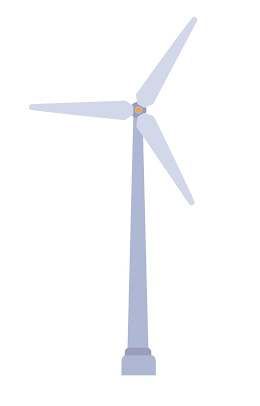All About Renewable and Non-renewable Resources
Resources refer to all the materials present in our environment which are used by living beings. Resources are considered to be very useful raw materials found in the environment. These are known as materials that are found in nature. They are beneficial to every individual in a variety of ways.
Define Natural Resources
Humans require many useful things available in nature to live on this planet. These are referred to as natural resources. Air, water, woods, animals, and minerals are some examples. When humans use natural things to make a new thing that increases its value, it is known as a man-made resource.

Types of Natural Resources
Natural resources are important for living beings. There are many ways of classifying natural resources. The most general category is the amount of resources available for human consumption. There are two types of energy resources: renewable and non-renewable energy resources.

What is a Renewable Resource ?
Renewable resources are those that cannot be depleted. They are always available and thus could be reused. The various types of Renewable resources are given below:
Renewable Resources : Examples
- Sun - The energy obtained from sunlight is solar energy. The sun is the ultimate natural resource for all living beings on the earth. Plants utilise solar energy and make their own food through photosynthesis.

- Wind - It is an important renewable resource required for the survival of living organisms. Air is important to carry out photosynthesis (the process by which green plants turn carbon dioxide and water into food using energy from sunlight) and respiration (the inhaling of oxygen and the exhaling of carbon dioxide) in plants and animals, respectively. The energy that is obtained from wind is termed as wind energy.

- Water - Water is required for survival. Humans use water for a variety of reasons, including drinking, washing, cooking, and cultivating crops. Hydro energy is generated by water flowing into a river or water held in a dam. Hydro energy is power that is generated from moving water such as rivers.
Converting hydro energy into electrical energy is a simple way to utilise it. Electrical energy is a specific form of energy that is the result of an electric charge. Electrical energy is a specific form of energy that is the result of an electric charge.

- Soil - Soil is a valuable resource as it is the layer in which plants grow. Living beings require food to live. Plants produce most of the food that is required by living organisms.
- Biogas - Biogas is a form of fuel that is a mixture of gases such as methane, carbon dioxide, hydrogen, and other gases produced by the breakdown of animal and plant wastes such as animal dung in the presence of water with the help of microorganisms. It is commonly used as a fuel for gas stoves, particularly in rural regions.
What is a Non-renewable Resource ?
Natural resources that are limited in quantity are referred to as non-renewable resources. These resources cannot be supplied or regenerated in a short duration of time. These resources cannot be reused. The various types of non renewable resources are as follows.
Non-renewable Resources : Examples
- Fossil Fuels- Fossil fuels are non-renewable energy sources. This means that they will ultimately be finished, which is why energy prices are rising. Fossil fuels consist of coal, natural gas and petroleum.
- Coal- Coal is used as a fuel, to generate electricity, and in factories and steam engines.
- Natural gas- Natural gas, often known as compressed natural gas, is an excellent alternative to petrol and diesel. It burns quickly and generates a large amount of heat. It's an excellent source of hydrogen.
- Petroleum- Mineral oil or crude oil are other names for petroleum. Petrol, diesel, cooking gas, and kerosene are all made from this liquid mineral. It can be found deep within the earth.
- Nuclear energy- This energy source involves use of radioactive material that is found in nature. Uranium is primarily used to make nuclear reactor fuel rods. Heat is generated when neutrons(neutral particles present in the atom) hit with the fuel rods. This converts water to steam, which is used to move turbines. As a result, it generates electricity.

Difference Between Renewable and Non-renewable Resources
1. Can be replaced by natural processes in a short duration of time or can be recycled.
1. These are natural resources that either
cannot be replaced or may take
millions of years to be replaced by natural processes like coal and oil.
2. It can be reused or recycled and used multiple times.
2. It cannot be reused or recycled.
3. Some of the examples are: wind
energy, solar power, hydroelectricity, geothermal.
3. Some of the examples are: petrol, coal, Natural gas, nuclear energy, fossil fuels.
4. There is no harm to the environment by using renewable resources.
4. Huge harm done to the environment
because of the harmful emissions.
Fun Facts
- Non-renewable resources like fossil fuels release harmful chemicals into the air when they are burned.
- Renewable resources are so abundant that they almost never run out.
- One wind turbine can generate enough electricity to power 1,400 households.
- Renewable energy creates three times more jobs than fossil fuels can create.
Summary
Resources refer to all the materials present in our environment which are used by living beings. Natural resources are materials present in nature and are used by humans. Renewable resources are those which cannot be depleted and could be reused. Examples of renewable resources include air, water, soil, solar energy, etc. Natural resources that are limited in quantity are referred to as non-renewable resources. The examples are coal, petroleum, etc.
Learning By Doing
In the given table, identify the following as renewable and non-renewable resources and name them.







